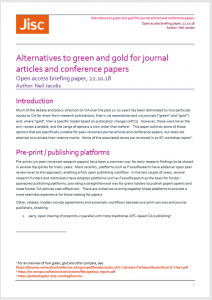This paper was written by Neil Jacobs and published as part of Open Access Week 2018. It can also be downloaded as a PDF document.
Introduction

Much of the debate and policy direction on OA over the past 10-20 years has been dominated by two particular routes to OA for short-form research publications, that is via repositories and via journals (“green” and “gold”) and, where “gold”, then a specific model based on publication charges (APCs). However, those were never the only routes available, and the range of options is now wider than before [1]. This paper outlines some of those options that are specifically suitable for peer-reviewed journal articles and conference papers, but does not attempt to evaluate their relative merits. Some of the associated issues are reviewed in an EC workshop report [2].
Pre-print / publishing platforms
Pre-prints (un-peer-reviewed research papers) have been a common way for early research findings to be shared in several disciplines for many years. More recently, platforms such as F1000Research have added an open peer review layer to this approach, enabling a fully open publishing workflow. In the last couple of years, several research funders and institutions have adopted platforms such as F1000Research as the basis for funder-sponsored publishing platforms, providing a straightforward way for grant holders to publish papers openly and meet funder OA policies cost-effectively. There are initiatives to bring together those platforms to provide a more seamless experience for those looking for papers.
Other, related, models include agreements and automatic workflows between pre-print services and journal publishers, enabling:
- early, open sharing of preprints in parallel with more traditional APC-based OA publishing [3]
- overlay journals, wherein journals select, review and curate collections of papers openly shared on pre-print services [4]
Submission fees
One of the criticisms made against the APC model is that good articles, that pass peer review first time, subsidise less good articles that are rejected by one or more journals, because APCs are only paid for articles that are published. Submission fees are, in theory, one way to address this, and so might be an especially attractive option for journals with high rejection rates. Submission fees also align the business model closely with the service being delivered by publishers. Some exploration has been done into this option [5], which concluded that journals were nervous about the possibility of reducing the number of submissions they receive. Perhaps as a result, submission fees are not (yet) a common model for OA journals.
Consortium / membership models
Perhaps more in line with the origin of scholarly publishing as a collective enterprise of the academy, there have been several initiatives that have built OA based on collective action. These include PeerJ [6], wherein a one-time membership fee allows authors to publish articles OA henceforward, and members are encouraged also to become reviewers. It also includes Open Library of the Humanities [7], which runs 23 journals through a library consortium model. This model can also work well for other forms of publication, such as monographs, as demonstrated by Knowledge Unlatched.
“Platinum” OA
Many (by some counts, most[8]) OA journals charge neither authors nor readers and, instead, operate on a variety of other business models. OA expert Peter Suber notes, “Some no-fee OA journals have direct or indirect subsidies from institutions like universities, laboratories, research centers, libraries, hospitals, museums, learned societies, foundations, or government agencies. Some have revenue from a separate line of non-OA publications. Some have revenue from advertising, auxiliary services, membership dues, endowments, reprints, or a print or premium edition. Some rely, more than other journals, on volunteerism. Some undoubtedly use a combination of these means” [9].
Unified scholarly communication platforms
In many ways, OA started in Latin America with the SciELO platform. SciELO (Scientific Electronic Library Online) is a bibliographic database, digital library, and cooperative electronic publishing model of open access journals (1250 journals). It is over 20 years old and operates in 14 countries mainly in Latin America. The Redalyc project (Red de Revistas Científicas de América Latina y El Caribe, España y Portugal) is an equivalent Portuguese language platform (1000 journals). Both offer a range of locally relevant statistical and other indicators, as well as aiming to boost their journals’ visibility in global services such as Web of Science. Although transnational, each platform builds on national infrastructures of both technology and the organisation of funding agencies or national ministries. In the sense they charge neither authors nor readers, then they are an enhanced version of “platinum OA”.
Social / sharing platforms
Platforms such as ResearchGate and Academia.edu are widely used by researchers to share papers. These are often illegally posted publisher versions of papers, available only to members of those platforms and, although joining is usually free, it is not clear that this kind of sharing is really OA. Furthermore, the business model of such platforms is often, though not always [10], based on selling user transaction data, which has become controversial for some. Nevertheless, the platforms are very popular with researchers, and papers shared there make up a large proportion of the total of those freely available on the web.
Informal sharing
Research papers are also available from personal web pages, departmental sites, via informal networks and provided on request direct to the author, sometimes mediated by services such as OA Button. Because this is fragmented and largely hidden, it is difficult to assess its scale, though it is likely to be significant, and it is also not very susceptible to policy level interventions.
[1] For an overview of how green, gold and other compare, see: https://libraries.universityofcalifornia.edu/groups/files/about/docs/UC-Libraries-Pathways%20to%20OA-Chart.pdf
[2] https://ec.europa.eu/futurium/en/system/files/ged/oa_report.pdf
[3] https://pubtechgator.bmj.com/tag/biorxiv/
[4] https://www.nature.com/news/leading-mathematician-launches-arxiv-overlay-journal-1.18351
[5] http://www.knowledge-exchange.info/event/submission-fees
[6] https://peerj.com/about/FAQ/
[7] https://www.openlibhums.org/site/about/FAQ/
[8] https://scholarlykitchen.sspnet.org/2015/08/26/do-most-oa-journals-not-charge-an-apc-sort-of-it-depends/
[9] http://www.earlham.edu/~peters/fos/newsletter/11-02-06.htm#nofee
[10] https://www.scholarlyhub.org/

This work is licensed under a Creative Commons Attribution 4.0 International License.
